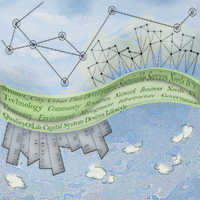Less Smart More City
Abstract
Smart is an expression used in recent years in science, and it refers to someone or something that shows a lively intelligence, with a quick learning curve and a fast response to external stimuli. The present scenario is dominated by the accelerated technological development that involves every aspect of life, enhancing the everyday tools through the use of information and digital processing: everything is smart, even cities. But when you pair the term smart to a complex organism such as the city the significance of the two together is open to a variety of interpretations, as shown by the vast and varied landscape of definitions that have occurred in recent years. Our contribution presents the results of research aimed at analyzing and interpreting this fragmented scene mainly, but not exclusively, through lexical analysis, applied to a textual corpus of 156 definitions of smart city. In particular, the study identified the main groups of stakeholders that have taken part in the debate, and investigated the differences and convergences that can be detected: Academic, Institutional, and Business worlds. It is undeniable that the term smart has been a veritable media vehicle that, on the one hand brought to the center of the discussion the issue of the city, of increasing strategic importance for the major challenges that humanity is going to face, and on the other has been a fertile ground on which to pour the interests of different groups and individuals. In a nutshell we can say that from the analysis the different approaches that each group has used and supported emerge clearly and another, alarming, consideration occurs: of the smart part of “Smart City” we clearly grasp the tools useful to the each group of stakeholders, and of the city part, as a collective aspiration, there is often little or nothing.
Downloads
References
Cassa depositi e prestiti. (2013). Smart City Progetti di sviluppo e strumenti di finanziamento. Cassa depositi e prestiti S.p.A.. Retrived at: http://www.cdp.it/static/upload/rep/report-monografico-smart-city.pdf.
Cavada, M., Hunt, D. V., & Rogers, C. D. (2014). Smart Cities: Contradicting Definitions and Unclear Measures. World Sustainability Forum 2014. SciForum, platform for open scholarly exchange and collaboration. doi: 10.3390/wsf-4-f004.
Della Ratta, R. F. (2007). L’analisi testuale computerizzata. In F. L. Cannavo L., Ricerca sociale, vol. II (p. 133-152). Roma: Carocci. ISBN: 9788843039630.
European Union (EU) Directorate General for Internal Policies. (2014). Mapping Smart Cities in the EU. Retrived at: http://www.europarl.europa.eu/RegData/etudes/etudes/join/2014/507480/IPOL-ITRE_ET(2014)507480_EN.pdf.
Gargiulo, C., Pinto, V., & Zucaro, F. (2013). EU Smart City Governance. TeMA Journal of Land use Mobility and Environment. doi: 10.6092/1970-9870/1980.
Giffinger, R., Fertner, C., Kramar, H., Pichler-Milanovic, N., & Meijers, E. (2007). Smart cities – Ranking of European medium-sized cities. Vienna UT: Centre of Regional Science. Retrived at: http://ign.ku.dk/ansatte/ignansatte/pure=files%2F37640170%2Fsmart_cities_final_report.pdf.
Greenfield, A. (2013). Against the smart city (The city is here for you to use Book 1). Kindle Edition. ISBN: 9780982438312.
Hall, R. E. (2000). The Vision of A Smart City. In proceedings of the 2nd International Life Extension Technology Workshop. Paris, Sep 28.
ITU-T International Telecomunication Union. (2014). Smart Sustainable cities: An analysis of definitions. ITU-T International Telecomunication Union. Retrived at: http://www.itu.int/en/ITUT/focusgroups/ssc/Documents/Approved_Deliverables/TR-Definitions.docx.
Jucevičius, R., Patašienė, I., & Patašius, M. (2014). Digital Dimension of Smart City: Critical Analysis. Procedia - Social and Behavioral Sciences. doi:10.1016/j.sbspro.2014.11.137.
Lebart, L., & Salem, A. ( 1988). Analyse statistique des donnèes textuelles. Parigi: Dunod.
Lombardi, Giordano, S., Farouh, H., & Yousef, W. (2012). Modelling the smart city performance. Innovation: The European Journal of Social Science Research. doi:10.1080/13511610.2012.660325.
M.I.T. (2013). Smart Cities Group. Tratto da Smart Cities Group. Retrived at: http://smartcities.media.mit.edu/frameset.html.
Mosannenzadeh, F., & Vettorato, D. (2014). Defining Smart City - A Conceptual Framework Based On Keyword Analysis. TeMA Journal of Land Use, Mobility and Environment. Special Issue, INPUT 2014 Conference. doi: 10.6092/1970-9870/2523.
Papa, R. G. (2013). Towards an urban planners’ perspective on Smart City. TeMA. Journal Of Land Use, Mobility And Environment, 6(1), 5-17. doi: 10.6092/1970-9870/1536.
Papa, R. (2014). Towards Smart City a scientific approach. Rome: Aracne editrice. ISBN 978-88-548-7024-6.
Paranyushkin, D. (2011). Identifying the pathways for meaning circulation using text network analysis. Berlin: Nodus Labs. Retrived at: http://noduslabs.com/research/pathways-meaning-circulation-text-network-analysis.
Rhodes, W. R. (1997). Understanding governance. Policy networks, governance, reflexivity and accountability. Buckingham Philadelphia: Open University Press. ISBN 9780335197279.
Rios, P. (2012). Creating the Smart City. Retrived at: https://archive.udmercy.edu/handle/10429/393.
Santis, R. D., Fasano, A., Mignolli, N., & Villa, A. (2013). Smart cities: theoretical framework and measurement experiences. Munich: Munich Personal RePEc Archive, paper No. 50207, posted 26. September.
Schaffers, H., Komninos, N., Pallot, M., Trousse, B., & Nilsson, M. a. (2011). Smart Cities and the Future Internet: Towards Cooperation Frameworks for Open Innovation. Future Internet Assembly. doi: 10.1007/978-3-642-20898-0_31.
The Climate Group, ARUP, Accenture and The University of Nottingham. (2011). Information Marketplaces The New Economics of Cities. Retrived at: http://www.theclimategroup.org/_assets/files/information_marketplaces_05_12_11.pdf.
Trobia, A. (2005). La ricerca sociale quali-quantitativa. Milano: Franco Angeli. ISBN 88-464-7018-4.
U.N. Department of Economic and Social Affairs. (2014). World Urbanization Prospects - The 2014 Revision. New York. Published by the United Nations ISBN 978-92-1-151517-6.

Copyright (c) 2015 Tema. Journal of Land Use, Mobility and Environment

This work is licensed under a Creative Commons Attribution 4.0 International License.
Authors who publish in this journal agree to the following:
1. Authors retain the rights to their work and give in to the journal the right of first publication of the work simultaneously licensed under a Creative Commons License - Attribution that allows others to share the work indicating the authorship and the initial publication in this journal.
2. Authors can adhere to other agreements of non-exclusive license for the distribution of the published version of the work (ex. To deposit it in an institutional repository or to publish it in a monography), provided to indicate that the document was first published in this journal.
3. Authors can distribute their work online (ex. In institutional repositories or in their website) prior to and during the submission process, as it can lead to productive exchanges and it can increase the quotations of the published work (See The Effect of Open Access)
